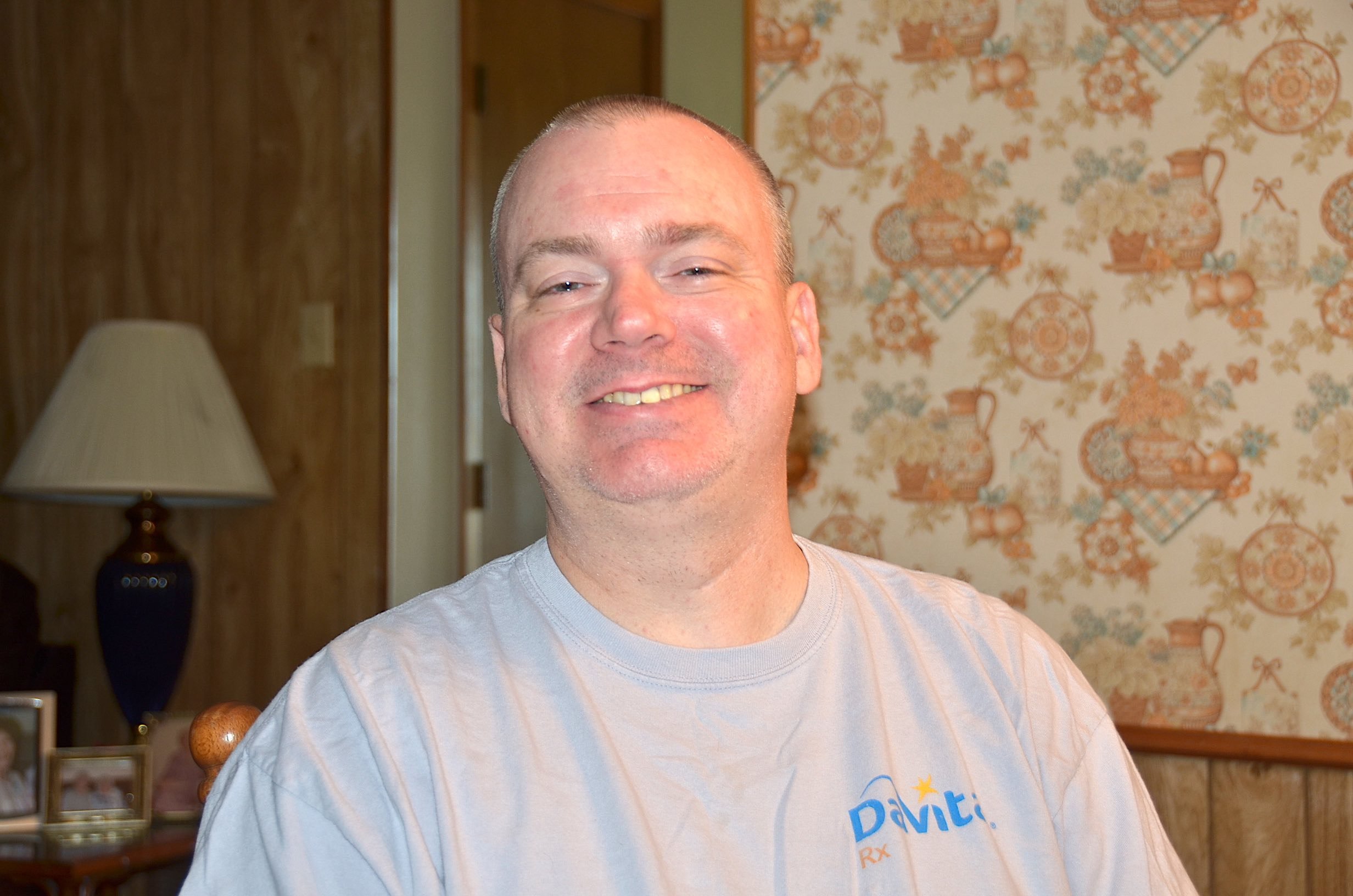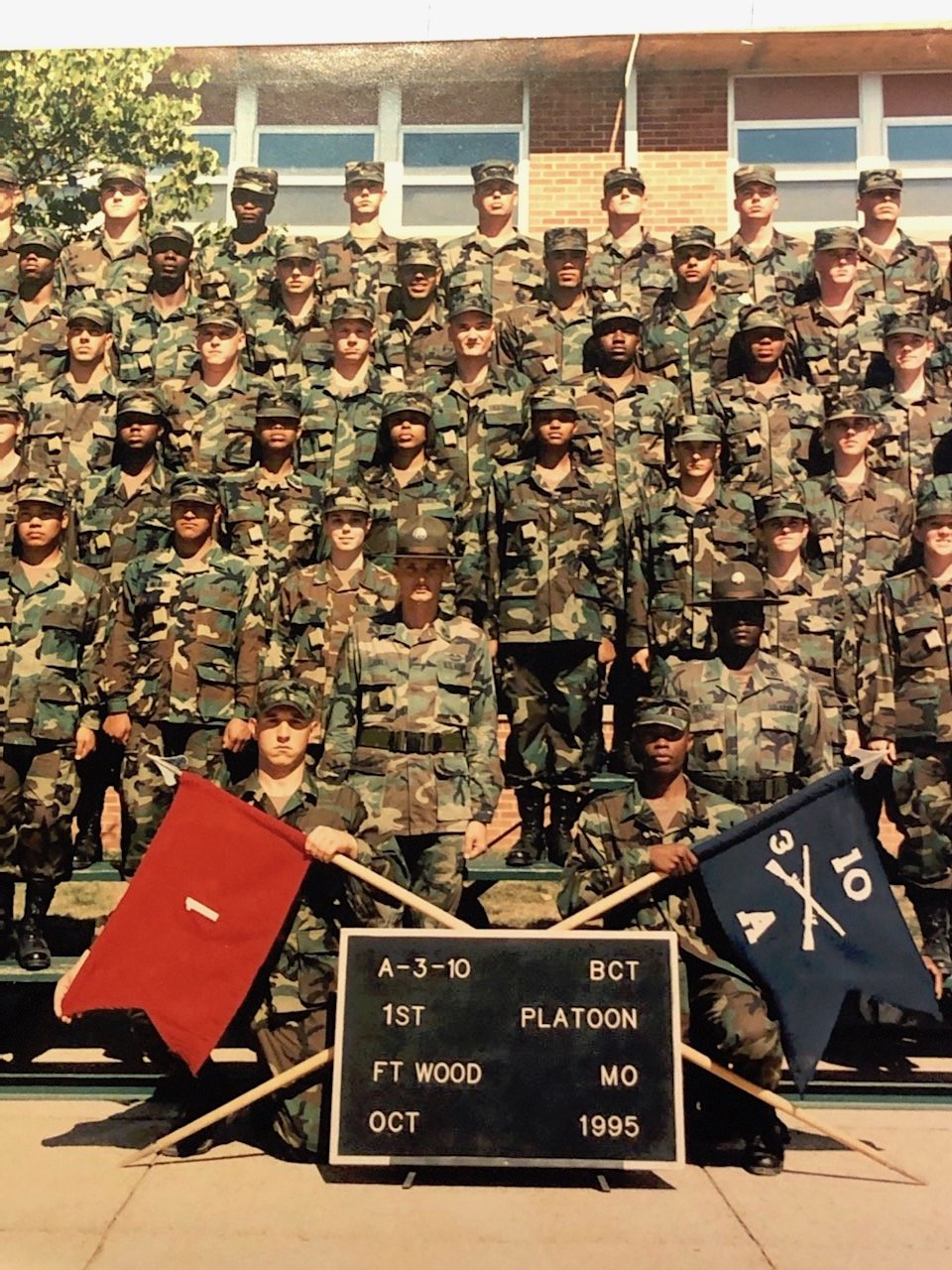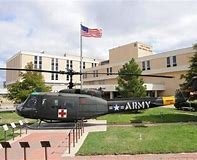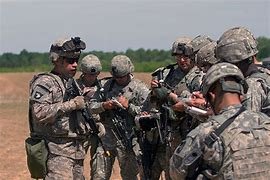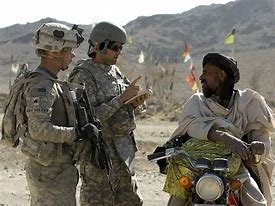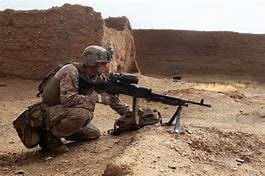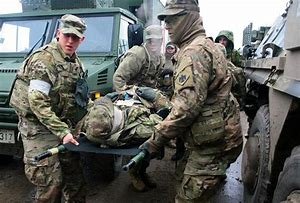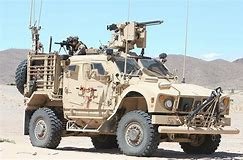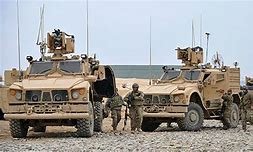Jerry Powell
Jerry Powell, 101st Airborne U.S. Army/Air Force 1995-2015, WILLS POINT, TEXAS
“I spent the next seven years at Fort Campbell with the 101st Airborne and I was taught one thing, “HOW TO KILL.”
EARLY YEARS:
Jerry Powell was born in Oklahoma City, Oklahoma on October 11th of 1975. He had three brothers, and two sisters. Jerry was the only brother who served in the military. “We moved from Oklahoma City to the Wills Point area in 1982,” said Jerry. “I made All-County as an offensive left tackle. I also played guard and center on the Wills Point football team and in my senior year I played both ways. I also ran track. I ran the 300 intermediate hurdles. In practice, I remember I clipped the first hurdle and fell and broke my wrist in about six different places. My running days were over,” laughed Jerry.
Jerry graduated in 1994. “I worked at Eckerd Drugs in Wills Point. My only route out of Wills Point was to join the military. My father was Army and I had friends from Wills Point that went into the Navy or Coast Guard. My dad was a combat engineer during WWII. His job was to build a Pontoon Bridge over the Rhine River into Berlin and France. He was in the Battle of the Bulge,” said Jerry.
“My dad stayed neutral about the war. He kept it put away, the stories and what they did. When I was young we played Army in the field with camo with one team good guys and other the bad guys. We used code. I researched it. We used hand signals etc. I went to First Monday and purchased books in depth. Never did I believe that one day I would be using those same skills in the military,” he said.
JOINING THE ARMY
With few job opportunities in Wills Point Jerry decided to join the military in September of 1995. He enlisted in Dallas and shortly after was shipped off to Ft. Leonard Wood, Missouri for boot camp. His MOS was 91 Bravo, combat medic. Jerry went to Fort Sam Houston for medical training. “They had the best food in the world,” Jerry told me. “I trained for anatomy and medical nomenclature, what medical terms meant and equipment and modules A,B,C etc. I finished the module portion and then took the written and hands on test. I learned how to do Injections, IV’s, drugs, burns, major and poly trauma. I also learned how to triage that patient, stop bleeding, major wounds etc. I was at Ft. Houston for about 20 weeks but it felt like a year,” laughed Jerry.
“From there I went to combat medical school and then Orthopedic specialist. I did my On the Job Training at Darnell Army Medical Center at Ft. Hood. That was at a hospital. Later when I was in the Air Force I taught medical students. It seemed to come naturally to me,” said Jerry. “I once had a Major come to me and said, thank you, for teaching us what you did. It helped us in Baghdad.”
“At the Ft. Hood hospital, I also learned about hands on casting. Setting broken hands for casting molds. How the OR (operating room) and ER (emergency room) operates. The NCO would praise us or go nuclear on us. There were many up and downs. I was at Ft Hood for six weeks,” said Jerry.
“From Fort Hood I went back to the 94th General Hospital at Ft. Bliss. My job was to see and treat patients. I was an E-4 writing referrals. That was very unusual. Word of mouth spread on what we did and that felt good. I ended up spending about three weeks at Ft. Bliss.”
BOSNIA ( 1997 to late 1998 )
Jerry picked for a deployment to Bosnia because of his combat medic experience, his rank and his experience in the medical field. “I was a specialist E-4. They liked my training and they looked at my time and grade and service. I was good to go. We were given a Bosnia handbook. Before going to Bosnia, we went to Ft. Benning, Georgia. There I trained up on what to expect in Bosnia. I learned a lot about land mines and how to get them out of there without hitting other land mines.
These were old school land mines, some were anti-tank, bouncing betties and anti-personal. I learned to speak part of the Bosnian language. I was sent to an air base in Hungary and several compounds in Sarajevo and parts of the country that were totally decimated. There was an extremely high security there. It was bad. Get up in morning at 0600, link up with team members to go to breakfast, move over to the clinic and get de-briefings. I would count the narcotics to make sure none had been used. Then we went to the clinic for a routine day. We had a lab and x-ray for patients. We had Physical Therapy and Psychiatry. We had the whole ball of wax there. No MRI capabilities but we could send patients to Sarajevo. If someone stepped on a mine, they would bring that patient to us and we would prep them and get them under control. When they were stable they were sent to another major hospital nearby. We always had a C-130 on standby and air evac them to Germany with no problem. Most of the evacs were non-combat related. There were over doses and people who got drunk and fell,” said Jerry.
“We had a kid who was putting a battery down into a sump of a Humvee. All the caps came off and splashed him in the face. He needed all his clothes removed and placed in a shower immediately. Above the clinic is where the Generals and all their aids stayed. They had very nice showers. I took this kid up there and stripped him down and I knew he had to be washed off for several minutes. In the end the kid was pissed that I had him in the shower that long. It turned out good. He could walk, talk and see again, that is all that mattered,” Jerry said shaking his head.
SEAGOVILLE TEXAS
When Jerry returned back to the United States he came back to SeagovilIe, Texas. “I felt very unappreciated. We were in Task Force 94 General and it felt like we were our own little family. We distanced ourselves from the rest of the mess that was going on. Most of the people back in the states were there to simply draw a check and spend the weekend to get it over with. There were a lot of new grads from Fort Sam who really didn’t care.
We had to do a PT test immediately on returning. So, everyone from Task Force 94 was there at the finish line for the run. We hated our Commander with a passion. After I passed my PT test they handed me a cup of coffee and a cigarette and they said there you go, congratulations. It made the Commanders head spin. She had a lot of grads around that couldn’t finish, but here was this fat boy who had been gone for a year that could do it. I just smoked my cigarette, drank my coffee and grinned.
Seagoville was a Reserve unit but had some active duty portions. I spent eight years in Seagoville. No one wanted to cross paths with me as a medic or as an orthopedic guy or as one of the guys that was highly trained.”
FORT LEWIS, WASHINGTON
“We were the medical support for ROTC training. We worked medical treatment for the firing range, the artillery range and land map range. To this day I still hold the record for treating patients there in a 24-hour period. I treated broken ankles, broken feet, blisters, teach them how to wear their socks, things like that. The record was 424 patients in a day. I had two other medics with me. I was senior medic on the scene. I had two Ranger medics and two of his lackies showed up. He was very proud of what I did. When it came to that ankle fracture, I had just enough material make a splint. That was the last operation I had and went back to Seagoville and got out of the Army. I spent a total of 14 years in the military including my Reserve time and received an Honorable discharge. I did not want to stay in the Reserves so I started looking at the other branches of the military.”
JOINING THE AIR FORCE
Jerry went to Texas A&M in Corpus Christi and majored in nursing. “I was a junior when I got there with all the background I already had. I wanted to be a flight nurse. I flew back to Dallas for my Air Force Reserve and I had to get a job and never finished my degree.
I had to go back to a military service that was deploying. It was in my blood. At that time the Air Force had developed their expeditionary forces. I had to go to that. I joined the Air Force Reserves. I had been to Bosnia and now I was ready for my next deployment. The Air Force, when I got there, was very political. Because I was prior service Army, some of the things they taught were completely incorrect. They wanted to use Hydrogen Peroxide on a wound and I told them Hydrogen Peroxide would destroy any new growth of skin and it was completely inappropriate. They didn’t like me and I got some of the worst deployments stateside and I loved it. I ended up as a teacher in Wichita Falls in the summer time teaching a course called “Med Red.” My Army training taught me to just make the best of my situation and I did. Then I was sent to Bastrop, Texas. They thought they were sending me to Hell on Earth. It was a very nice building and I was a medic. My MOS was 407 in the Air Force. I had two lesser medics under me. It was nice. I was the lead medic. Good food, air conditioning, big windows. I did not mind it a bit.
They were going to send me to Baghdad but I pissed off this Lieutenant about the semantics of how much gear and what we should take over there. He eventually made Captain and I was taken off the list. While I was at Bastrop they sent me over to Ft. Hood. That is where I had my first seizure, all attributed to lack of sleep.
I was in the Air Force Reserve and went on 8-month medical leave for my seizures.
I started to get seizures quite often and could tell many times when they were about to come on. I had previous head injuries as a kid playing football and I sometimes think that may have contributed to my seizures. They thought the seizures was the first sign of my PTSD. This was a civilian neurologist. He thought what happened to me in football and my trauma in Bosnia may have contributed to the PTSD.”
THE 101st AIRBORNE
Jerry eventually got out of the Air Force and went to the Army recruiter. “I wanted to go back as a medic. I had some EMT experience. They said, no. They said I had three choices. Drive a truck, bomb squad or infantry. I decided on infantry. I went back in as an E-5 in the regular Army. I got my orders and was stationed at Fort Campbell, Kentucky in the 101st Airborne.
Once I got to Ft. Campbell I was then assigned to the Combat Brigade, 1st, 2nd, 3rd or fourth. Brigade would then send you to a Company.”
When Jerry received his orders for the 101st Airborne in Ft. Campbell he was 36-years old. What chances did you think you had at that age to make the 101st Airborne? I asked Jerry. He started laughing. “I guess they sent me because I was an NCO (Non-Commissioned Officer). Age didn’t really play into it. I was considered old man-two. There actually was someone there older than me.
There were 129 guys in the Company. I thought I was going to end up in the mailroom for old guys. The Sargent Major asked us, “who is not supposed to be here?” One guy raised his hand and said, “I don’t’ belong here. We all looked at each other. No one gives that answer,” said Jerry. “I thought I was going to Ft. Hood. But my choices where you can go two years or you can deploy with us and then go to Ft. Hood. So, I thought, I guess I am stuck here. Ft. Campbell is called “The Black Hole.” Once you get there you never leave. I ended up in Ft. Campbell for seven years.”
I knew all about the 101st Airborne and their history. I never thought I could pass the rigorous tests and physical training. I figured I would be a failure there. The 10-mile runs, the 24-mile marches, I made it. Even though my rotator cuff was torn. I had a lot of injuries but I powered thru it. My squad leader was a mean SOB from Louisiana. He shook my hand, told me I had made it, and I had done a good job. He said you are a good NCO. I got his approval. It meant the world to me.”
SHORT HISTORY OF THE 101ST AIRBORNE
Since 1974 the 101st Airborne Division has been the United States Army’s “Air Assault” Division. The Division is capable of lifting, by helicopter, a 4,000 soldier combined arms force up to 150 kilometers behind enemy lines in one lift. Having approximately 281 helicopters, including three battalions of Apache attack helicopters, makes the “Screaming Eagles” the most versatile fighting unit in the Army. It is the world’s only air assault division. The 101st consists of three infantry brigades, Division Artillery, Division Support Command, the 101st Aviation Brigade, the 159th Aviation Brigade, the 101st Corps Support Group, and various other separate commands stationed at Fort Campbell, Kentucky.
The United States Army began testing the viability of parachute units in 1940, after seeing the success of British and German paratroop units in the early days of World War Two. The first tests, conducted at Fort Benning, Georgia, were so successful that soon the army was forming Parachute Infantry Regiments (PIR). Once the United States was thrust into the war, the Army authorized Airborne Divisions. The 82nd and 101st would serve in the European Theater and later the 11th Airborne Division would see action in the Pacific.
On June 6, 1944 the Pathfinders of the 101st Airborne Division were leading the way into France for Operation Overlord: D-Day. The 101st would spend 33 days in combat before returning to England to receive replacements and train for their next operation.
In September 1944, the 101st Airborne Division made its second combat jump. This time the jump was in Holland for Operation Market Garden. The Division spent 72 days in combat before being moved to France for refit.
On December 16, 1944, the Germans launched a surprise attack with thirteen armored and infantry divisions in the Ardennes region of Belgium. The front of the Americans was in danger of collapse. On December 17th the 101st received orders to move north out of France and defend the town of Bastogne, Belgium. This was the beginning of the Battle of the Bulge.
Bastogne was a hub of highways that moved through the Ardennes, a forested area that forced the German mechanized forces to use these roads. The Germans surrounded the city on December 20th, isolating the 101st and some elements of the 10th Armored Division. On December 22nd the Germans issued a demand for surrender. The acting Commander of the 101st, General Anthony C. McAuliffe, gave his famous reply of “Nuts.”
In the next eleven years the 101st Airborne was activated and deactivated three times. Finally, in 1956 the Division was reorganized as a five-brigade division and came back to the Regular Army and its permanent home of Fort Campbell, Kentucky.
The First Brigade of the 101st Airborne Division was deployed to Cam Ranh Bay, Vietnam on July 29, 1965. They were the third United States Army unit to arrive in country.
During the early days of Vietnam, the Division made its transition from parachutes to helicopters as the method of insertion. In July of 1968, the Division changed its name to the 101st Air Cavalry Division. The next year, on August 29, 1969, the Division changed its name again to the 101st Airborne Division (Air Mobile), making it the Army’s second air mobile division.
In late 1971 and early 1972 the Screaming Eagles left Vietnam and returned to Fort Campbell. During almost seven years of action in Vietnam, the 101st Airborne participated in 15 campaigns. Most notable were Hamburger Hill in 1969 and Firebase Ripcord in 1970.
Since the end of the Cold War, the 101st has served proudly in the Persian Gulf War in January of 1991, conducting an air assault deep into enemy territory in the Iraqi desert. The Division sustained no soldiers Killed in Action during the “100-hour war” and captured thousands of enemy prisoners. The 101st Airborne Division (Air Assault) was the first conventional unit to deploy in the War on Terror. In 2002 the Division’s Third Brigade participated in Operation Anaconda facing an intense period of combat in the rugged terrain of Afghanistan as part of Operation Enduring Freedom. In 2003 the Screaming Eagles, led by Major General David Petraeus invaded Iraq as part of Operation Iraqi Freedom. The Division has made a second deployment to Iraq in November of 2005 to conduct counterinsurgent operations and to train Iraqi security forces.
General Order Number Five, which gave birth to the 101st Airborne Division in the early days of World War II. “The 101st Airborne Division…has no history, but it has a rendezvous with destiny.” The Division has certainly lived up to those prophetic words. The 101st is one of the most famous fighting forces in the world. Thousands upon thousands of proud soldiers have worn the distinctive “Screaming Eagle” shoulder patch, which is arguably the most recognizable unit insignia in the United States military.
PUTTING ON THE PATCH
“Putting that 101st Airborne patch on my shoulder was the proudest moment of my life. I retired from 425 but I can always say the 101st Airborne was my home,” said a smiling Jerry.
“When I first put it on, it was awkward,” said Jerry. “When placed on the right sleeve it is considered a combat patch. Which meant you spent at least 30 days in an eminent danger zone. “The Right Way is the Army Way,” according to Jerry.
Two Tours of Afghanistan
“I spent the next seven years at Fort Campbell with the 101st Airborne and I was taught one thing, “HOW TO KILL.” Seven years of hard training. They taught us how to kill with small arms, anti-tank weapons and AT-4s. We learned how to channel the enemy into a certain point. We learned the correct use of air assets and using them for anti-IED’s. Everybody wants to kill us, so we have to kill them first. Physical strength is very important. We would carry fuel cans loaded with water and we would just run with them. If we had to move logs or wood we would learn how to flip that telephone pole. Mental strength is very important. History of the 101st is very important. I was pseudo-intelligence. I had to go to a lot of meetings on weapons and briefings. I briefed a British Captain who had an extremely deep accent. So, I was talking about a bend in the road. We all knew that a bend in the road is IED Heaven. I started explaining to him how common this was and he started to chew me up and down. My first Sargent came over and said, ”J-Dub I knew exactly what you meant so don’t let this get you down.”
We would sometimes spend eight straight hours of stress shooting, both during the day and night. We had to learn how to wear full body armor correctly and how to handle prisoners. We were also taught how to clear houses. We did a huge amount of that.
The 101st can be anywhere on the globe in 72-hours. With the helicopters today, we can be dropped all over the world.
There were rumors we were going to be sent to Afghanistan. The first Sargent came to me and said you are very important to the company, you are very important to me. He said you have an option, you have a year or so left. He said I want you to go to Afghanistan. I said for you, I will go. It was 2010.
I landed in Bravo Company, 502nd in Afghanistan in infantry. I was in the 101st from 2007 thru 2012,” Jerry said.
“We flew into Kurdistan to a civilian airport. I was going as light infantry. We were on standby to fly into Kandahar Airfield on a C-130.
We arrived at the Airfield and headed over to a large hangar. We hear this voice come over the loud speaker, Incoming missiles, prepare for impact, incoming missiles prepare for impact.
We are the 101st, can’t nobody hurt us. We are here to square this place away. We are here to kill the Taliban. We are here to catch Mullah Omar and we are going to make this place a Democracy.
I was a highly trained killer at this point and very accurate with small arms and using air assets. I was highly trained to figure out who the bad guys were.
That was very difficult in Afghanistan, because you could be talking to a farmer who says we love Americans blah, blah, blah and the next day he is planting an IED. We went out on ops to learn how to interact with the locals. We learned about the IED’s, the explosives.
We were in high pursuit of an asset named Mullah Omar who had one eye. We only had one picture of him. We were not considered Delta Force, Rangers, or Navy Seals . We were perceived as brothers to them.
If any of us say the sky is Purple, roger that, the sky is Purple. We were trained to work with everybody and everybody appreciates the 101. They know that we are just machines to kill and kill. We trained at Kandahar for about a week, hopped on another C-130 and head to a camp called FOB Wilson (Forward Operating Base). It is horrible. My best buddie catches pneumonia. It is 129 degrees when we hit the ground.
We were there to replace 10th Mountain Army Unit. Their job was to clear the land of IED’s and Taliban and to gather intel on the locals. They were also on the hunt for Mullah Omar. We started doing our patrols and interactions. Everyone was living in metal containers, what we called “Train Cars.” Some of these contained eight men living quarters.
I had no air conditioning in my container and stayed by myself. It took them several months to get my air conditioning working. In addition, I caught all the new soldiers.”
Kandahar and other bases around Iraq and Afghanistan relied heavily on HESCO Bastion or Barriers for protection.
The HESCO BASTION or Barrier is primarily used for flood control and military fortifications. Galvanized Hesco Bastion is made of a collapsible wire mesh container and heavy duty fabric liner, and used as a temporary to semi – permanent levee or blast wall against explosions or small-arms.
Below is an excerpt from an NPR war correspondent, David Gilkey, who was imbedded with Jerry’s Bravo Company, 101st outside Kandahar City in 2010.
https://www.npr.org/sections/pictureshow/2010/07/06/128334660/afghanfight (101st Bravo Company in Afghanistan)
Excerpts from UNDER FIRE, THE FIGHT HEATS UP IN AFGHANISTAN by David Gilkey NPR
NPR photographer David Gilkey has embedded with the 101st Airborne Division outside of Kandahar City in southern Afghanistan. The mission for American soldiers in this region is to cooperate with the Afghan National Army to secure the area — pushing out the Taliban and empowering locals to protect themselves. But that’s easier said than done.
The effort in Kandahar requires routine joint patrols throughout a 16-mile stretch of Taliban stronghold. The main, paved roads are laden with homemade explosive devices and thus too dangerous for travel.
The soldiers must navigate a jungle-like terrain of fields and farmland in 100-degree heat to continue their outreach efforts, talking to farmers and field hands along the way.
On a recent patrol, the 101st came under heavy fire and engaged in a 4-hour battle with Taliban insurgents. There were no casualties, but exhaustion has settled in. Army officials have said that the key to winning the war is winning the trust of locals. But until American forces can rid the region of the Taliban — which would allow the military to move freely and alleviate fear among Afghan civilians — face time with those locals will remain limited.
David Gilkey was taking pictures and covering stories of war-related events in Afghanistan around the time of his death. Multiple attacks were happening between the Afghan military and Taliban fighters, and so Gilkey traveled to Marjah, located in southern Afghanistan, to cover the conflict. Gilkey was traveling with the Afghan military to cover fights near Marjah. On June 5, 2016, a rocket-propelled grenade fired by the Taliban hit the Afghan Army vehicle that Gilkey shared with his native handler Zahihullah Tamanna, and an unknown Afghan army driver.
“David and I roomed together in Afghanistan,” said Jerry. “We would go out on patrol and meet with the locals and try and talk with them and see if they needed anything. When the sun starts to set and you have that “LAST CALL TO PRAYER,” the locals put their agricultural tools up and pick up their AK-47’s. Every day for six months we got attacked twice a day. Once in the morning and once in the evening. In the morning before they picked up their tools to farm and right after their mosque visit in the evening. Most of the locals wore flipflops but we had credible intel that some of the fighters were coming from Germany and we were on the watch for those wearing black leather boots. We never saw them where we were but we got intelligence reports all the time.
Most of what we saw were those in country dress and burkas. We hit the Taliban pretty hard and soon we were referred to as “THE MONSTERS.” We were blowing up two rows of roads at a time. Eventually we got things under control.
When we first got there the streets were deserted. We saw them crossing the streets, playing soccer. It was weird,” said Jerry. “One of the things we learned early on, you can’t trust the locals. We just didn’t trust them.” The Rules of Engagement (ROE) and under the Uniform Code of Military Justice (UCMJ) determine when a soldier can fire and when he can’t. It is a very fine line to hoe when your split-second decisions in the heat of the battle will dictate whether you live or die.”
“This place was a mess,” said Jerry. “They could have an AR-47 like we can have a concealed weapon. RPG’s were a no go. We had a young kid who gave us intel that he saw three Taliban with RPG’s and should he shoot them. That news made it to the top of command and they lit into him. The kid was stupid enough to slam the door on the way out. We were supposed to go out with the Afghans. Most of them were either stoned or stupid,” he laughed. “We were always more on guard and more apprehensive. Especially about the information you put out. You never knew what these guys were going to tell others about an operation. We would tell them we are going on routine patrol and then go on a major operation. We just wouldn’t share intel with them. Every single night we had, what was called, the CUB, (combat update brief) and the BUG, (battle update brief). All the NCO’s would crowd into the CPs. We would listen to the Battalion Commander about what was going on. There were no Afghans there. They were never privileged to that and even slept about 600 meters in each direction.
When it came to Rules of Engagement, (ROE) it had to be reaction. Muscle memory is not uncommon for a warrior.”
THE CONSTANT SHELLING
“Every day twice a day for six months we were attacked. Small arms and RPG’ed ( Rocket Propelled Grenades). We called this “Prime Time.” It became like a regular routine. 1800, it is Prime Time. By 1900 ZULU everyone stopped eating, everyone put out their cigarettes, everybody manned their posts because we were fixing to get hit. Every day, twice a day, it just became routine. I hate being dirty, I hate not getting a shower. Every day, I would grab eight bottles of water, hit the hygiene place. Fill it up, shave, wash and walk back to my hooch and get ready for my day.
We had no way to cook or refrigerate food. We had a 55-gallon drum cut in half and charcoal or some wood and we had JPA as a starter. We had no silverware, everything was eaten by hand. I sit down to eat and about that time, Prime Time started. When I got back to my shave kit, it had been RPG’d. We believe there were some turncoats among us and they had reported me as being there. That is when I came to the realization this was the real deal.
The attacks grade on you mentally. There are so many small checks and balances in your mind. If it is not muscle memory you will forget to do something. Simple things like placing your spare magazines correctly on your body so that when you got into a firefight at night you can rub your thumb across it and tell whether it is an empty or full magazine. I pat myself down every time I went out. I wasn’t superstitious, just wanted to be ready. I learned to accept death. You can’t live day to day with what might happen. What is going to happen is going to happen. There was always a brief and debrief after every mission. You could get complacent. This is what I feared the most, that enemy in your mind,” said Jerry.
“The boss named us the “Hunter Care Team.” We only did night operations. The rest of the time we were Battle Captains. I was the Battle Captain and worked exclusive with the Battalion. It was ordered that no one was to touch me. I got a call from Battalion. It was the middle of the day and I had platoons spread all out in the area. They said, Bulldog 7 we are going to lay in some artillery. We have spotters on top of a mud hut.
We had 5 minutes before the artillery hit. Next thing I know we are getting incoming. I was a nervous wreck.
I got a call from one of the towers saying I had a herd of sheep passing. I have a translator to my left. He tells me they are moving into the sheep. Meaning the Taliban were moving into the sheep setting up IED’s. I said, I need a Predator or a Scan Eagle now. Battalion had them tied up, I could not get either one. I had three Canadians sitting on the top of the mountain with nothing to do. They saw them putting down the IED’s. They asked for what kind of rounds I needed and I said I needed high explosives. They opened up on them. Just greased them. There were three of them. I won a Dr. Pepper out of that one. They bet me I could not grease them all.”
BEST WEAPONS
“The M240 Bravo was my favorite small weapon in the 101st also called a “squad assault weapon.” It fired a 556 round, but it was automatic. It was light to carry and could lay enough firepower. It was a multi-functional weapon.
The 203-grenade launcher was another of my favorite weapons of choice. It was attached to the bottom of your M-4. You could lay in smoke or grenades and it was also multi-functional. The only thing the Taliban was afraid of was the 9mm pistol. There were so many executions by the 9mm. We used chainsaws sometimes to get a clean line of fire, but the biggest weapon they were afraid of was the 9mm pistol. We had shotguns and 50calibre machine guns, but to get their attention was the 9 on the side.
Air assaults were much different. When they learned how much firepower from an Apache or Kiowa could do especially when we could do an RC (remote controlled or radio control) burn at night. There they could run thru the frequencies on the radio and detonate any RC explosives that were being placed or were being handled.
I was the company master driver for the MRAPS and I liked it. I trained on everything from the old MRAPS to the new M-ATV’s and the 4×2’s. We ended up with the MATV’s. It was light, fast and you could place any weapon system on it.
I always liked being in the rear of the convoy. The place they loved to hit was the 2nd or 3rd vehicle in line. The plan was to trap the rest of the vehicles in. I rode in a lot of three-vehicle convoys but did a lot of ops in much larger convoys. It all depended on the missions. I had a lot of what we called, just a feeling or an eerie feeling, about some missions. Something was about to happen type of mission. I would ask my buddies; did you feel it? Everybody in the truck felt it. There were those missions where you would think, well this is it, this one is going to hit us.
You always looked for the guy who drove the “jingle” trucks or the ones that swerved at you or the little bitty white car that came speeding at you. That was always my worst fear. Route 1 was just a two-lane road. I would always keep to one side of the road. That gave me a little bit of “duck time” if they came right at me. I was lucky with the IED’s. One day we took out 17 of them. Clearance guys were sweeping the roads every day for us. There were quick rabbit up ops and others planned accordingly.
We had drop down visors on our vehicles to view at night like a night vision goggle. That made me extremely nauseous. I couldn’t do that. It was a lot easier for me to go with low lights and follow the dust trails,” Jerry said. “I drove everything from an ambulance, MRAP, a bridge layer to an old school 5-ton. I drove them all,” said Jerry. “But my favorite was the MATV’s.”
“The day I was supposed to come home I went out on one of those eerie feeling ops. We were out at an Afghan Police Station. I always stayed in my vehicle. This guy comes at me, dressed in an all-white robe. Taliban usually always wore all white. I called him in and was told, yeah we are tracking this guy. Two Afghans came by and went up to him and talked to him and he left. When we left the Police station to go back to the Forward Operating Base, (FOB) someone fired a red flare. We were told to spin up and make sure your guns are hot. The Police Station was going to be attacked. I thought to myself, damn I am going home tomorrow. I don’t need this shit.”
ROUTE CRYSTAL OP
“This is when I lost it. There was a four way in a field. There was an IED placement here and an IED placement on the other side. We took 14 casualties that night. The Commander said F this, we have MASSCAL, MASSCAL, MASSCAL (MASS CASUALTIES). Which meant anything that had an engine, a jet, a helicopter, vehicle or whatever was to move to our point. Luckily, I was not on that patrol. The night before I had driven over an IED, I had straddled it. I, for some reason, was the guy who could drive everything. My co-driver just told me where to drive and I just straddled an IED. I had 40,000 lbs. of demo on that truck. I drove back to where we were at and was on standby.
We had everything you could think of, Chinooks, Blackhawks and other equipment to mark where the injured were located. You take a glow stick on a piece of string and you swing it. With that the pilots can pick an (LZ), landing zone.
They brought some of the casualties to where we were located. We had about seven bodies hidden under blankets. None were injured, they were all dead. Under Universal Code of Military Law, a soldier is NOT to identify an American casualty. They have our DNA and our picture for that. There is no need for an American soldier to go over and look at this mess. This E-6 said, J-Dub, come over here and tell us who these people are. The first guy just had a shoulder and a piece of torso left on his body. On his shoulder was a tattoo with a picture of all his kids. I knew this guy. Only two weeks previous I had an argument with him. I came to the second guy, and all of a sudden, I saw a huge white light. Different than you could ever expect. Something in my head said, you are done, go back to where you are at. So, that is what I did. In my heat, I felt I am thru with this war. F this, I am done. I went back to where I was at and sat down for six or eight hours, without moving. I didn’t talk, didn’t eat or drink water. My best buddy, who was a Lieutenant, came walking up with his hands up in the air. I am cussing and yelling at him. He had (TBI), Traumatic Brain Injury. I told him to get on the bird and get evac. I went nuclear. I found out my (PO),Project Officer had lost the top of his head; a leg was shot but he was still alive. Later, I found out he had been killed. I was a wash. I was done. My First Sargent was livid because of what they asked me to do.
They announced over the radio my Lieutenant’s battle roster number and his name, and said, he was dead. This was my close friend who lost the top of his head. Again, this was totally against Army regulations. It is called (GO-1), General Order Number One,” Jerry said taking a break.
“Working directly for the Boss, I had to see every casualty that came thru there. The (CAO), Casualty Assistance Officer gathered their gear. I had to pack their goods and saw pictures of these guys and their families. This all happened after I attempted to identify those seven bodies. I was taken back to FOB Wilson and told to put on a clean uniform. I was going back to Kandahar Airfield and eventually back to Atlanta, Georgia. I followed these orders to a tee, but in my heart, I was done. I was on a (MLA), Military Leave of Absence. I considered going (AWOL), Absence Without Leave.
When I was on MLA and back at home in Wills Point, Texas, all I could eat were BLT’s. I ate, I would throw it up. I threw up every day for two weeks. I was still seriously considering going AWOL. I started thinking about my First Sargent and my brothers in the 101st, and I just did not want to let them down.”
2nd TOUR OF AFGHANISTAN
“I was sent back to Afghanistan and met with my First Sargent and was given a de-briefing of all the personal changes since I had went back to the states. He was glad I was back in country. We had gotten the new MRAPS by this time.
MRAP -A design of vehicle from various vendors were deployed as part of the MRAP program. MRAP vehicles usually have “V”- shaped hulls to deflect explosive forces from land mines or IEDs below the vehicle, thereby protecting vehicle and passengers. MRAPs weigh 14 to 18 tons, 9 feet high, and cost between US$500,000 and US$1,000,000.
I could go anywhere on these things. These monsters looked like something out of Mad Max. There were four of us inside including First Sargent, a medic and a man on the 50 caliber. Everything that happened to me before, I just kept it all inside.
We usually rode with a three-truck minimum with several guns and personal. We had to carry 48 hours of food, fuel and water. Boss said keep that truck gassed up at all times. We are back at Forward Operating Base Wilson and sent out to different Command Operation Posts (COPS). We were going to another FOB that was blown up. We moved from RC South (near Pakistan) to RC East, an area that I found out that another friend of mine had been killed by an IED. We chased the Taliban all over the deserts. Of course, the helicopters are faster than the Taliban on motorcycles.
We are now in the M-ATV’s. On top we have the 50 Calibers. One BIG gun. I am the driver. We did a lot of mounted patrols.
INFO: The Oshkosh M-ATV is a Mine Resistant Ambush Protected vehicle developed by the Oshkosh Corporation for the MRAP All-Terrain Vehicle (M-ATV) program. Intended to replace the M1114. It is designed to provide the same levels of protection as the larger and heavier previous MRAPs but with improved mobility.
The Battalion Commander shows up in my truck. An MRAP will only go so fast because it weighs so much. I have my foot to the floor in these 18-ton behemoths. The Commander wants to go faster and faster. Me and the first commander just look at each other. We were ordered to go south to a COP area just to see what was going on. It was not a good scene. Remember this place is hit every day, twice a day.
He knew I was the best driver and fighter they had. I had a 240 Bravo kid in the vehicle with us. First thing the kid does is hit the Fire Support System, the fire suppression system. Halogen goes everywhere, this giant flash of white fills the vehicle. I thought to myself, this is what death feels like. It wasn’t bad, it wasn’t bad at all. I had thought we had been hit with a mortar or an 82. Once the air filled, I realized it was just a big screw up.
We built a place call COP Yates. That was the name of my Project Officer (PO) who had been killed, the Lieutenant. Life there was not bad at all as far as military life goes. However, we had no racks to sleep in. So, we had to sleep on the ground. We were driving in a 3-vehicle convoy, and were always last in the convoy. That way we could always back out, swerve around and get our guns on the bad guys. Or we could flip around and tow that damaged vehicle out. Even if it was seven trucks we were always the last truck in line. We are driving along and the man on the 50 cal says I think I see a surfaced land mine. These are different than an IED. We let the rest of the vehicles know what is up. My First Sargant who is as close as a brother to me, goes and checks it out. He jumps out and starts walking towards this land mine and shuts the door. I turned around and told that 50 cal guy, and said, if anything happens to him I will stick that barrel up his ass. When he got out there it was simply a green sand bag that had been blown away. He kicked it and I thought that was the end of the Boss.
This was the winding down of the operation. On another mission we passed a jingle truck and all of a sudden I felt like it was the end. The First Sarge and I both felt like that was the end. Went back to the FOB without any problems. Just a feeling we both had.
When an individual in our unit was killed we had roll call. All the senior NCO’s from the Battalion would come and sit. They would call the roll of everybody in the Company. All the names called in alphabetical order. They got to this individual who was dead. They would call his name three times. They went on to the next person. It just broke my heart.
Next day I packed my bags and got on the Freedom Bird. I was headed back to Fort Campbell. Got debriefed and was told about this new MOS in Electronic Warfare. He said, you are smart and you would be interested in it. So, I stayed and went into Electronic Warfare Training and graduated from the course.
I landed in 425 Alaska and was told I was going back to Afghanistan. I said, look, I need a shoulder repaired, a neck that needs repair and I have all these injuries. They told me to go get checked out. I had surgery on my neck and surgery on my rotator cuff. I had seizures. I had flashbacks. I was taken off the mission. Nineteen-point six months, we will call it twenty months brother. I got out August 14th 2015. I retired for good.
I also was diagnosed from TBI, (Traumatic Brain Injury). I fell and broke my orbital socket. I was seeing a psychologist in Alaska and diagnosed for PTSD around 2013. The Army knew I had PTSD but was ready to ship me over for a third tour in Afghanistan.
For the first couple of years back at home, I had severe flashbacks. Twice I ended up in the lockdown unit.
My wife and I got into an argument and I got into a flash. I completely tore a locked door off the hinges, threw it to the side and went after her. She had two dogs that were biting me and I just threw them aside. When I got to her throat I realized who she was. I just stopped and backed off. A huge amount of anger. There are still a lot of things afterwards that would have caused my PTSD.
The memories and my dreams in Afghanistan, they were crazy. What they write books about,” said Jerry finishing his story.
PTSD SERIES FOR VETERANS MEMORIAL: Author
I had interviewed several veterans in my “MEET OUR VETERANS,” segments for our website www.vzcm.org and realized four of the last five interviewees shared with me they had been diagnosed with PTSD.
My brother, Jimmy Smith, served with the Marine Corps in Vietnam in 1968. I didn’t know the person who came back from that war. He suffered severe PTSD issues. Over the years Jimmy had gotten involved with the drug cartels and served time in prison. In his 40’s his body, racked with long term drug abuse, liver damage and Agent Orange exposure, passed away from cardiac arrest at a rest stop on a trip from Texas to Florida.
I wanted to learn and understand the symptoms and treatment for Post-Traumatic Stress. I visited a veteran’s, group therapy session, in Tyler several times. I talked to Doctors, Psychiatrist, five PTSD diagnosed veterans and the VA for a 6-Part Series I was working on for the website. In that research I learned about a treatment called SGB, Stellate Ganglion Block. That is when I met Jerry Powell. He was doing volunteer work at our Veterans Memorial Visitor’s Center. He shared with me his history and PTSD diagnosis. I told him about SGB and, being a medic in the military he started doing his own research. We continued to collaborate about the treatment and Jerry agreed and was willing to give the procedure a try.
I talked with Dr. Sean Mulvaney. He is a former Navy Seal and medical doctor and considered one of the top PTSD/SGB doctors in the world. He was treating veterans with a 15-minute procedure where he injected the patient with a drug called Ropivacaine into the Stellate Ganglion in the neck. The injection goes into the vein and is directed to the Amygdala part of the brain. The center for fear and anxiety.
Jerry took a PCL-5 test. The standardized test the VA uses to verify a veteran with symptoms of PTSD. The highest score is an 80. Jerry scored a 78. We flew to Annapolis, Maryland on the 17th of September 2019 for the injection.
THE MIRACLE IN ANNAPOLIS
Jerry Powell in Annapolis, Md.
Comments after SGB Treatment:
Four hours after his SGB treatment, Army veteran Jerry Powell and I went out to eat at a restaurant about a block from Dr. Sean Mulvaney’s office. As we finished our meal Jerry asked me to look over my shoulder. As I turned my head he asked, “Do you see what I see?” I turned my head back and Jerry was smiling. “Do you want to do an experiment with me,” he asked. “Are you ready?” I answered back.
We got up from our table and headed out of the restaurant to drive the hundred yards to the front of the Annapolis Shopping Center. It had been over 20 years since Jerry had stepped foot in a mall. It was time for him to test the SGB block. The advice Dr. Mulvaney had told Jerry in their talks in his office earlier.
As we entered the front doors of the mall I deliberately walked a couple steps behind Jerry. I wanted to see his reactions and ask him questions as we strolled along. We entered the main corridor and Jerry turned right and saw a Sears store and to his left a long way down was a JC Penney’s. Jerry turned right and walked towards the Sears store. He kept his eyes straight ahead, occasionally looking at the storefront displays to his right and left. On a couple of occasions looking at other shoppers but mostly focused on where the men’s department was as we entered Sears. We got to the back and I asked him what he was feeling. He said, “normally, I scan the store looking for a way out. Where are the exits? Perhaps a table I can dive under, looking for that escape route.” He then looked towards the ceiling at the security camera. “Always look for those,” as he pointed up towards the ceiling. Jerry saw the shirts on the men’s rack and looked at the prices and noticing they were 50% off. “I like this one,” he said. Several customers passed by but he was more focused on the shirts and the prices. After several minutes he asked if I would walk down the Penney’s stores to see if maybe he could find a similar one at a cheaper price. Sure, let’s go. Again, I stayed a few paces behind Jerry taking note of his reactions. Once again, his eyes were focused forward, occasionally looking into the other stores. As we entered JC Penney’s Jerry looked for the men’s department and found it in the back. I tagged along. Jerry looked at several shirts but most were overpriced and asked if we could go back to Sears. Once again we walk the Mall. I felt like I was shopping with my wife. Out looking for the best bargains.
Jerry tried on the Extra Large then the XXL and chose the XL. We walked over and a saleslady from Croatia with a thick accent asked Jerry how he was doing. He quickly struck up a conversation with her and asked where she was from. He was recalling his days in Bosnia.
As we left the store I immediately saw her walking towards us. She was about 30 yards away. I glanced over at Jerry. His eyes fixed on the exit door. As she came closer I stayed fixed on Jerry. She passed within a foot of him and in a couple of seconds he started smiling. I asked him what was going on. I knew. “Yesterday,” he said, “I would have been walking fast to the other side of the mall.” The woman he just passed was Islamic wearing a full Hijab. “I would have thought she was a suicide bomber, today she is just a customer,” said Jerry.
I realized at that moment Jerry Powell was back. The 101st Army Airborne light Infantry soldier was home. His war in Bosnia and Afghanistan were over. His demons from PTSD were gone.
8-months after the SGB injection:
In a phone interview I talked to Jerry eight months after his SGB Injection.
Any flashbacks? “Only one minor flashback in last eight months. That was from a motorcycle that was revving up his engine when he passed my house. It took me back to Afghanistan and hearing all the motorcycles. They used them to set IED’s.
What about lack of sleep? “No sleep problems. I used to stay up all hours of the night. Hated to go to sleep because of all the bad memories.
Would you recommend SGB when all has failed for a PTSD veteran and why? I would definitely recommend SGB. It was awesome. It was kind of like the match that lit the fire for me. I would be completely lost without that treatment. I see things like I have never seen before.
How many drugs were you taking before the SGB and how many today? “I took up to 17 drugs before SGB, now taking about five and they are all for seizures I have. Overall I am in a great place,”
If you are a veteran and have tried one on one counseling or group therapy and have taken multiple drugs and you are still in a bad place. I encourage you to please research and consider the SGB Injection.
It is being used on a trial basis at a California VA Hospital. It is not for every veteran, but again, it just may save your life.
Please contact me, Phil Smith, PR Director at the Veterans Memorial in Canton for more information. (903) 567-0657. Please learn more about the SGB 15-minute procedure on our website at www.vzcm.org. Part-6 has more information on the treatment. It is FREE to veterans diagnosed with PTSD thru the Dakota Meyer GoFundMe page.
“I had the SGB treatment and I went from being late for a meeting in New York City to driving in the country with no place to go.” Dakota Meyer – Medal of Honor recipient, Afghanistan
Jerry Powell, thank you for your service to our country while serving in the United States Air Force and the U.S. Army. Your courage and bravery will not be forgotten.
NOTE: Meet other Veterans from Van Zandt County by going to the top of www.vzcm webpage and click on MEET OUR VETERANS and click one of the (5) branches of services and the veterans last name first and click to read.
“Every Veteran has a story to tell.” Phil Smith
GOD BLESS OUR VETERANS AND GOD BLESS AMERICA
(ALL photos on this Facebook page are ©2020, Phil Smith and Van Zandt County Veterans Memorial. NO unauthorized use without permission) All Rights Reserved.

